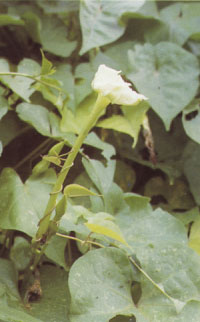- Bignoniaceae - Tropical zones of Central and South America
 |
Family:
Genus: Tanaecium
Species: Nocturnum
Common Names: Huangana Huasca, Koribo, Pum-ap, Samedu-ap
Tanaecium Nocturnum is a herbaceous climbing vine that produces white flowers. The leaves are predominately uniform green, they are shaped like hearts and are about 6 inches (15 cm) in length and 4 inches (10 cm) wide, they grow directly out of the stem of the vine. The flower bodies are 6 inches (15 cm) long, tubular shaped and have 3 inch (8 cm) white petals. The vines smell like almonds when they are broken or crushed.
This climbing vine grows natively in Central America, especially in southern Panama. It is also native to the Amazon, West Indies and the Yucatan Peninsula, Mexico. Though this plant has not been extensively studied, there is ethnographic research detailing the aboriginal preparation and use of this plant to make a strong hallucinogenic snuff called Koribo by the natives.
The main active alkaloid present in Tanaecium Nocturnum is hydrocyanic acid, this compound is toxic. Several elder shaman from the Paumari tribe have been paralyzed from the waist down due to their daily intake of the snuff. Roasting the leaves is reported to breakdown the hydrogen cyanide, while leaving the psychoactive compounds intact. There still needs to be lot more research done on this plant to verify its potential properties.
Traditional Use: The Paumari tribe of the Purus River Basin have used Koribo during many of their special occasions, as a rite of passage, in healing ceremonies and coming-of-age ceremonies for prepubescent girls. Before any child in the Paumari tribe can begin eating the meat of a new animal, a special ceremony must be performed by the elder tribesmen.
The men of the tribe form a circle and take Koribo by inhaling the snuff through the hollow leg bone of a water bird. The tribesmen then call the animals' spirits and imitate the animal that the child will soon be consuming. The tribesmen chant sacred songs, and dance in ritualized motions. In healing rituals, the shaman will consume Koribo, and then treat the patient by violently sucking on the patient's legs, arms or stomach, depending on the source of the illness and pain. The shaman will then run into the forest to expel the disease by vomiting. When the shaman returns to the patient, he produces an insect, a bone or some other foreign object which he claims to be the source of the illness. Although the men of the tribe are the only ones to consume the snuff, during village festivals the women of the tribe consume a tea made from two heaping tablespoons of the roots and bark of the plant.
Traditional Preparation: To make the hallucinogenic snuff, Koribo, the Paumari tribesmen gather the leaves of a mature vine, they shred the leaves, then roast them over and open pit fire until they are completely dry. The dried leaves are then crushed and pulverized with a mortar and pestle until a very fine powder is produced. The powder is then mixed with a tobacco powder that is produced in the same way.
Medicinal Use: The Paumari shaman use the snuff to perform magical healing ceremonies. Other tribes use preparations made from Tanaecium Nocturnum to treat diarrhea, migraine headaches, to make a balm to stop the itch of rashes and there are even reports of it being used as an aphrodisiac. The Creoles tribes of Columbia squeeze the juices out of the freash leaves to make an extract that they use to get rid of lice and fleas.
Traditional Effects: At lower doses the snuff has been reported to produce a mild drowsiness that over takes the user. The mind easily wanders and deep introspection becomes difficult. At higher doses, the shamans claim that Koribo allows them to enter into the animal spirit world and communicate with the animals. As well, the snuff has a somnambulant effect, creating vivid dream states, sleep walking, semi-hypnogogic (half awake / half asleep) trances and puts the user into a mild hallucinatory dream world.
References
Ghillean Prance, Campbell, David AND Bruce Nelson. 1977. The Ethnobotany of the Paumari Indians. Economic Botany.(PDF)
Ratsch, Christian. 2005. The Encyclopedia of Psychoactive Plants: Ethnopharmacology and Its Applications. Park Street Press; Rochester, VT.
Schultes, Richard E; Hofmann, Albert; Ratsch, Christian. 2001. Plants of the Gods: Their Sacred, Healing and Hallucinogenic powers. Healing Arts Press; Rochester, VT.
Yaniv, Zohara; Bachrach, Uriel. 2005. The Handbook of Medicinal Plants.CRC Press.
http://www.entheology.org/